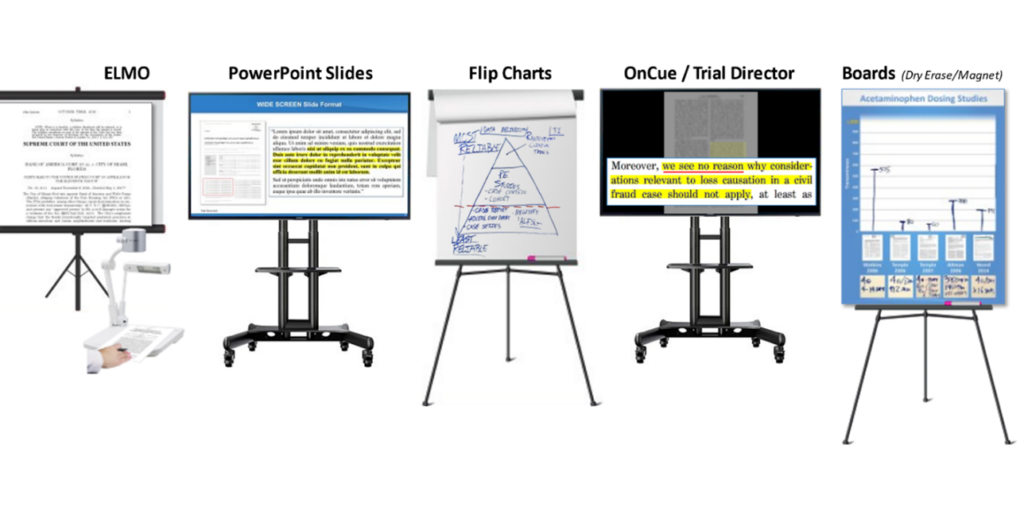Access professional trial presentations that enhance your courtroom strategy.
Exactly How Trial Presentations Enhance Your Disagreement and Convince Jurors
Trial discussions act as a pivotal device for boosting lawful debates and encouraging jurors. By incorporating visual aids, narrative structures, and psychological involvement, attorneys can develop an engaging situation that reverberates on multiple levels. The strategic use of visuals not only clarifies intricate information yet also records jurors' interest a lot more efficiently than words alone. However, the art of narration plays a just as critical role in changing accurate proof into an engaging story, forming jurors' assumptions - trial presentations. Understanding these elements can significantly impact test results, elevating the concern of how each component adds to this detailed dynamic.

Importance of Visual Help
Visual aids play a crucial role in enhancing the efficiency of test presentations, as they can considerably increase target market involvement and retention of information. In the context of a trial, where jurors are entrusted with processing complicated information, aesthetic help offer to simplify and make clear crucial points. Graphes, graphs, and photos can communicate data and ideas that might otherwise bewilder or confuse jurors, permitting for a much more straightforward understanding of the proof presented.
In addition, aesthetic aids help in maintaining juror focus throughout the process. By breaking the uniformity of verbal statement, these devices can punctuate critical debates, making them a lot more memorable. Reliable visual help can likewise evoke emotional actions, which can be critical in convincing jurors to line up with the speaker's story.

Crafting Engaging Stories
A compelling story is necessary in trial presentations, as it acts as the foundation of efficient persuasion. It allows lawyers to weave with each other facts, evidence, and psychological components into a meaningful story that resonates with jurors. This narrative framework enables jurors to recognize the complexities of the instance while leading them through the attorney's argument.
To craft a compelling narrative, lawyers should concentrate on clarity and coherence. This includes developing a clear protagonist-- often the customer-- and outlining their journey via the occasions in inquiry. Providing the realities in a sensible sequence enhances comprehension and keeps engagement. Additionally, the use of dazzling descriptions can create mental photos that aid jurors picture the events, making the narrative more remarkable.
Moreover, integrating key motifs throughout click here to read the presentation enhances the core message and aids in retention - trial presentations. The story ought to not only share information however additionally stimulate a feeling of justice, highlighting the risks included. Ultimately, a sound story promotes a connection in between the jurors and the instance, placing the attorney's debate as both credible and compelling, therefore raising the probability of a beneficial verdict

Engaging the Court Emotionally
Reliable jury involvement depends upon the attorney's ability to attach with jurors on an emotional degree. This connection can significantly affect jurors' perceptions and their utmost decision-making. Utilizing psychological appeals enables attorneys to humanize the situation, changing abstract legal concepts right into relatable experiences. By presenting real-life tales or testimonials, lawyers can stimulate empathy and empathy, cultivating a deeper understanding of the concerns at risk.
Aesthetic help, such as photographs or videos, can additionally boost emotional involvement, offering jurors with brilliant depictions of the situation's human components. Crafting a narrative that highlights the struggles and victories of the people entailed ensures that jurors see beyond the lawful debates and recognize the human consequences of their decisions.
An attorney's passionate distribution can reverberate with jurors, enhancing their psychological investment in the case. It's important to balance emotional appeals with valid proof, making sure that jurors feel obliged to act while remaining based in the reality.
Structuring Your Presentation

The body of the discussion ought to be logically fractional right into bottom lines, each supported by engaging evidence. It is beneficial to make use of storytelling strategies to weave truths into a story that jurors can easily adhere to. Visual aids, such as graphes and videos, can boost comprehension and involvement, assisting to highlight critical items of evidence.
Real-World Study
Taking a look at real-world instance studies offers vital understandings right into the art of test presentations and persuasion. The defense team efficiently utilized an approach that combined high-profile professional statements with multimedia discussions, which astounded jurors and inevitably affected their choice.
Another notable instance is the "McDonald's you could try here Coffee Instance," where the complainant's lawyers made use of visuals photos of the injuries received by Stella Liebeck. trial presentations. This stark visual proof played an essential role in communicating the seriousness of her burns, causing a considerable jury award. Such instances show that impactful test discussions commonly pivot on the reliable assimilation of visuals and narration to evoke emotional responses from jurors
Furthermore, the "Casey Anthony Test" highlighted the relevance of narrative comprehensibility and credibility. The prosecution's failing to develop a compelling timeline reduced their convincing power, highlighting the necessity of a well-structured presentation. Assessing these instances exposes that successful test discussions need tactical preparation, psychological interaction, and the ability to reverberate with jurors' values and beliefs.
Conclusion
Test discussions substantially enhance arguments and encourage jurors with the strategic usage of visual help, engaging narratives, and psychological interaction. By streamlining complicated information and fostering links with the audience, these elements produce a memorable and impactful experience. A well-structured discussion balances sob stories with valid evidence, inevitably resonating blog with jurors' worths. The combination of these strategies not only affects decision-making however likewise highlights the importance of reliable communication in the court room.